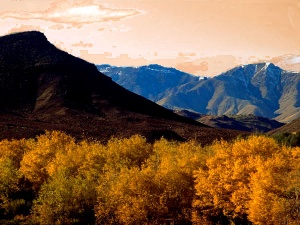More actions
mNo edit summary |
mNo edit summary |
||
| Line 1: | Line 1: | ||
[[Image:Kir - Llangon foothills.jpg|thumb|right|Llangon foothils, [[Kir]] ]] | [[Image:Kir - Llangon foothills.jpg|thumb|right|Llangon foothils, [[Kir]] ]] | ||
The '''Heyalar t’L’langon''' are Vulcan's largest | The '''Heyalar t’L’langon''' are Vulcan's largest mountain range, separating [[Shi'Al]] and [[Kir]] from [[Khomi]], and [[Gol]] from [[Khomi]]. They stretch from the [[Thanar Sea]] coast in the east to [[Gol#Kolinahru Monastery|Mount Kolinahr]], where they join with the '''Heyalar t’Gol'''. | ||
The highest peak is Mount [[Tar'Hana]], an active volcano roughly 400 kilometers southeast from [[Shi'Kahr]. East of Tar'Hana lies a region called Ah'firr. While small as far as mountains go and with no significant peaks, the area is littered with a labyrinth of gorges and caves; and has long served as a natural barrier between [[Khomi]] and [[Kir]]. The Ah'firr region receives more rainfall than any other region in eastern [[Na'Nam]], with some portions receiving upwards of 800ml of precipitation per decade. | The highest peak is Mount [[Tar'Hana]], an active volcano roughly 400 kilometers southeast from [[Shi'Kahr]]. East of Tar'Hana lies a region called Ah'firr. While small as far as mountains go and with no significant peaks, the area is littered with a labyrinth of gorges and caves; and has long served as a natural barrier between [[Khomi]] and [[Kir]]. The Ah'firr region receives more rainfall than any other region in eastern [[Na'Nam]], with some portions receiving upwards of 800ml of precipitation per decade. | ||
Central Llangon is heavily forested, with the northern slopes covered in [[Ic'tan]] conifers and [[Indu'kah]]. The southern slopes are steep and craggy, but with a number of plateaus that exist at heights of 500–1,100 meters. | Central Llangon is heavily forested, with the northern slopes covered in [[Ic'tan]] conifers and [[Indu'kah]]. The southern slopes are steep and craggy, but with a number of plateaus that exist at heights of 500–1,100 meters. | ||
Revision as of 09:04, 4 November 2015

The Heyalar t’L’langon are Vulcan's largest mountain range, separating Shi'Al and Kir from Khomi, and Gol from Khomi. They stretch from the Thanar Sea coast in the east to Mount Kolinahr, where they join with the Heyalar t’Gol.
The highest peak is Mount Tar'Hana, an active volcano roughly 400 kilometers southeast from Shi'Kahr. East of Tar'Hana lies a region called Ah'firr. While small as far as mountains go and with no significant peaks, the area is littered with a labyrinth of gorges and caves; and has long served as a natural barrier between Khomi and Kir. The Ah'firr region receives more rainfall than any other region in eastern Na'Nam, with some portions receiving upwards of 800ml of precipitation per decade.
Central Llangon is heavily forested, with the northern slopes covered in Ic'tan conifers and Indu'kah. The southern slopes are steep and craggy, but with a number of plateaus that exist at heights of 500–1,100 meters.
The central southern part of the Heyalar t’L’langon, lying at an altitude of 1,800 meters and above, separates Khomi from Kir and reaches towards the Tchol t’Glu'mas (Deep Sea Bay). This area is mostly a high desert, though the southernmost part tapers off into montane savannahs. It is also rich in minerals and metals and in the past has often been fiercely contested by the neighboring kingdoms.
Western Llangon is characterized by high peaks and scarce, but lush pockets of vegetation. The region has traditionally been the source of high-grade marble and rare timbers.
The Llangon Mountains have long harbored strings of monasteries and secret brotherhoods, the most famous of which are the Tinsha Monastery and the healer monks of T'Shen.
